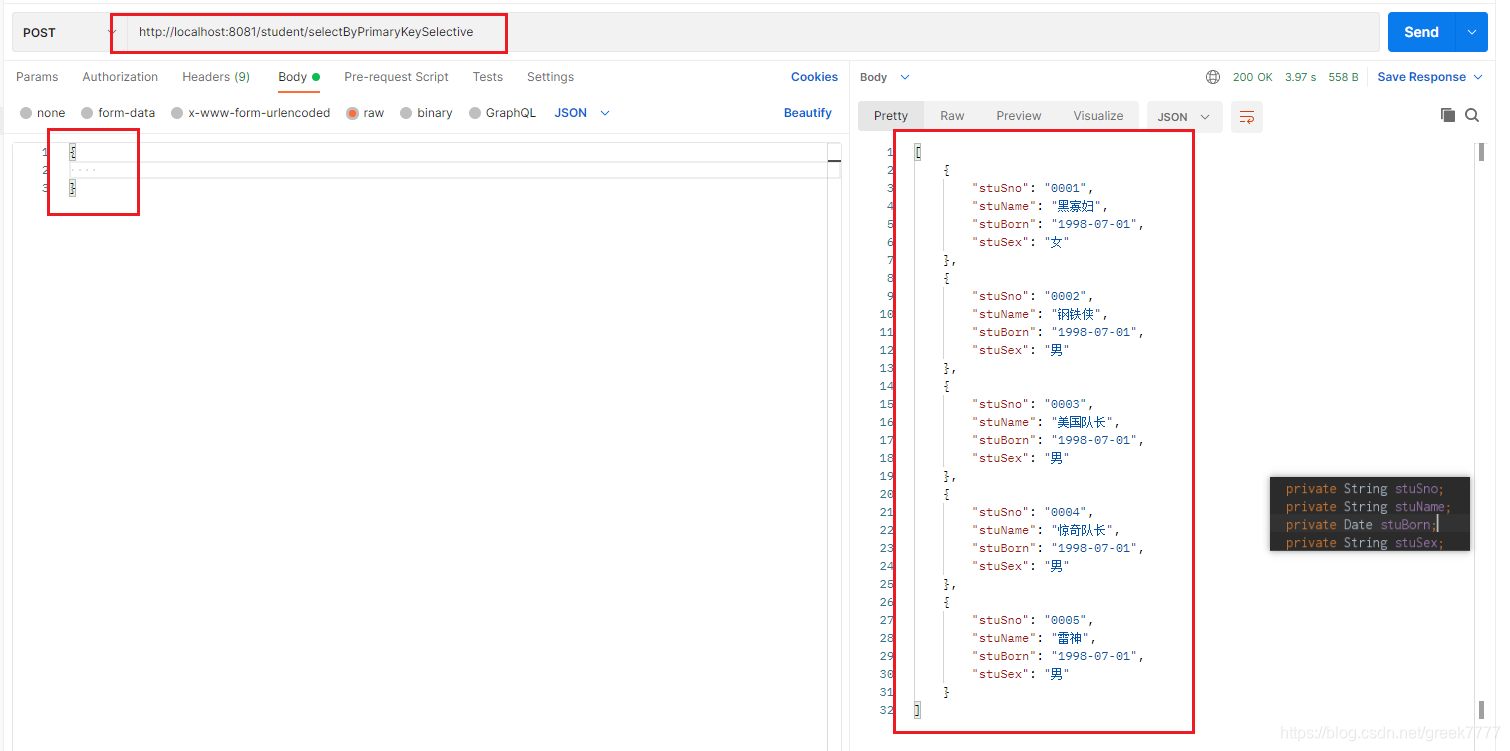postman测试@pathvariable,@requestparam,@requestbody发送情况
1、三种方式简单说明
1.1、@Pathvariable
通过占位符的方式获取入参,前端示例:url:http://localhost:8080/system/student/${stuSno}
也即是从路径里面去获取变量
后端:
/**
* @param stuSno 学号
* @return 学生信息
* @description 根据主键获取学生信息
*/
@GetMapping("/selectByPrimaryKey/{stuSno}")
public Student selectByPrimaryKey(@PathVariable String stuSno) {
return studentService.selectByPrimaryKey(stuSno);
}
这种情况是方法参数名称和需要绑定的url中变量名称一致时
若是若方法参数名称和需要绑定的url中变量名称不一致时
后端:
/**
* @param stuSno 学号
* @return 学生信息
* @description 根据主键获取学生信息
*/
@GetMapping("/selectByPrimaryKey/{stuSno}")
public Student selectByPrimaryKey(@PathVariable("stuSno") String sno) {
return studentService.selectByPrimaryKey(stuSno);
}
注意:前端传参的URL于后端@RequestMapping的URL必须相同且参数位置一一对应,否则前端会找不到后端地址
1.2、@RequestParam
- 作用
将请求参数绑定在控制层(controller)方法参数【springmvc注解】 - 语法
@RequestParam(value="参数名",required="true/false",default="")

value:表示前端传过来的值名称,如果你不设置,那就默认使用服务端使用的参数名称(stuSno)
不设置:
前端:
http://localhost:8081/student/selectByPrimaryKey1?stuSno=0001
后端:
public Student selectByPrimaryKey1(@RequestParam String stuSno) {
设置
前端:
http://localhost:8081/student/selectByPrimaryKey1?sno=0001
后端:
此时@requestParam中value=“sno” value可以省略 直接输入“sno”,类似于@RequestMapping
public Student selectByPrimaryKey1(@RequestParam("sno") String stuSno) {
这时候前端传sno并非stuSno,需要在@requestParam中value设置sno
required:是否包含该参数,默认为true,表示该请求路径中必须包含该参数,如果不包含就报错
2021-08-15 02:26:30.495 WARN 4736 --- [nio-8081-exec-2] .w.s.m.s.DefaultHandlerExceptionResolver : Resolved [org.springframework.web.bind.MissingServletRequestParameterException: Required request parameter 'sno' for method parameter type String is not present]
defaultValue:默认参数值,如果设置了该值,required=true将失效,自动变为false,如果没有传该参数,使用默认值;比如说此时 后端直接写成 defaultValue=“0001”

- 示例说明
后端controller
/**
* @param stuSno 学号
* @return 学生信息
* @description 根据主键获取学生信息
*/
@GetMapping("/selectByPrimaryKey")
public Student selectByPrimaryKey1(@RequestParam(value = "sno",defaultValue = "0001",required = false) String stuSno) {
return studentService.selectByPrimaryKey(stuSno);
}
前端暂时使用 postman
1.3、@RequestBody
@RequestBody主要用来接收前端传递给后端的json字符串中的数据的(请求体中的数据的)
- @RequestBody直接以String接收前端传过来的json数据
后端代码
/**
* @param stuSno 学号
* @return 学生信息
* @description 根据主键获取学生信息
*/
@GetMapping("/selectByPrimaryKey3")
public Student selectByPrimaryKey2(@RequestBody String jsonString) {
// 使用fastjson解析json格式字符串为json对象
JSONObject jsonObject = JSONObject.parseObject(jsonString);
// 获取学号
String stuSno = jsonObject.getString("stuSno");
return studentService.selectByPrimaryKey(stuSno);
}
前端postman
需要通过fastjson转换json字符串为json对象从而获取相应的值,否则报错
- @RequestBody以简单对象接收前端传过来的json数据
实体类
package com.geekmice.springbootrequestparam.pojo;
import com.fasterxml.jackson.annotation.JsonFormat;
import java.io.Serializable;
import java.util.Date;
public class Student implements Serializable {
private String stuSno;
private String stuName;
private String stuBorn;
private String stuSex;
public String getStuSno() {
return stuSno;
}
public void setStuSno(String stuSno) {
this.stuSno = stuSno;
}
public String getStuName() {
return stuName;
}
public void setStuName(String stuName) {
this.stuName = stuName;
}
public String getStuBorn() {
return stuBorn;
}
public void setStuBorn(String stuBorn) {
this.stuBorn = stuBorn;
}
public String getStuSex() {
return stuSex;
}
public void setStuSex(String stuSex) {
this.stuSex = stuSex;
}
@Override
public String toString() {
return "Student{" +
"stuSno='" + stuSno + '\'' +
", stuName='" + stuName + '\'' +
", stuBorn='" + stuBorn + '\'' +
", stuSex='" + stuSex + '\'' +
'}';
}
}
dao层
/**
* @param student 学生信息
* @return 返回学生信息
* @description 根据学生对象获取学生信息
*/
List<Student> selectByPrimaryKeySelective(Student student);
xml
<!--获取学生信息-->
<select id="selectByPrimaryKeySelective" resultType="student" parameterType="student">
select
<include refid="Base_Column_List"/>
from student
<where>
<if test="stuSno != '' and stuSno != null">
stu_sno = #{stuSno}
</if>
<if test="stuName != '' and stuName != null">
and stu_name = #{stuName}
</if>
<if test="stuBorn != '' and stuBorn != null">
and stu_born = #{stuBorn}
</if>
<if test="stuSex != '' and stuSex != null">
and stu_sex = #{stuSex}
</if>
</where>
</select>
service
/**
* @description 根据学生对象获取学生信息
* @param student 学生信息
* @return 返回学生信息
*/
List<Student> selectByPrimaryKeySelective(Student student);
@Override
public List<Student> selectByPrimaryKeySelective(Student student) {
return studentDao.selectByPrimaryKeySelective(student);
}
controller
/**
* @param student 学生对象
* @return 获取对应学生信息
* @description 用户选择获取对应的学生信息
*/
@PostMapping("/selectByPrimaryKeySelective")
public List<Student> selectByPrimaryKeySelective(@RequestBody Student student) {
return studentService.selectByPrimaryKeySelective(student);
}
postman效果
- @RequestBody以复杂对象接收前端传过来的json数据
复杂对象:Tim
package com.geekmice.springbootrequestparam.pojo;
import java.util.List;
/**
* @author pmb
* @create 2021-08-15-4:34
*/
public class Tim {
// 团队id
private Integer id;
// 团队名字
private String timName;
// 获得荣誉
private List<String> honors;
// 团队成员
private List<Student> studentList;
public Integer getId() {
return id;
}
public void setId(Integer id) {
this.id = id;
}
public String getTimName() {
return timName;
}
public void setTimName(String timName) {
this.timName = timName;
}
public List<String> getHonors() {
return honors;
}
public void setHonors(List<String> honors) {
this.honors = honors;
}
public List<Student> getStudentList() {
return studentList;
}
public void setStudentList(List<Student> studentList) {
this.studentList = studentList;
}
@Override
public String toString() {
StringBuffer stringHonor = new StringBuffer("荣誉开始:。。。");
for (String str : honors) {
stringHonor.append(str);
stringHonor.append("+");
}
StringBuffer stringTim = new StringBuffer("团队成员开始:。。。");
for (Student student : studentList) {
stringTim.append(student);
stringTim.append("-");
}
stringHonor.append(stringTim);
return stringHonor.toString();
}
}

postman
- @RequestBody与简单的@RequestParam()同时使用
controller
postman
- @RequestBody与复杂的@RequestParam()同时使用
controller
postman
- @RequestBody接收请求体中的json数据;不加注解接收URL中的数据并组装为对象


3、不同之处&应用场景
我认为在单个参数提交 API 获取信息的时候,直接放在 URL 地址里,也就是使用 URI 模板的方式是非常方便的,而不使用 @PathVariable 还需要从 request 里提取指定参数,多一步操作,所以如果提取的是多个参数,而且是多个不同类型的参数,我觉得应该使用其他方式,也就是 @RequestParam
